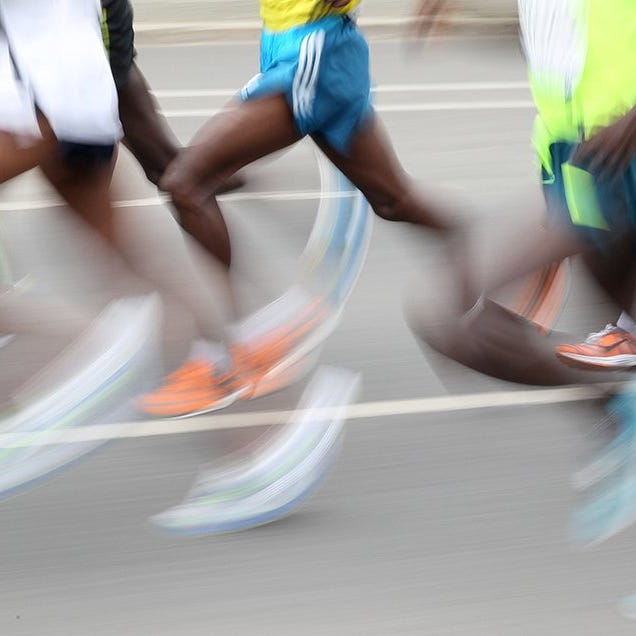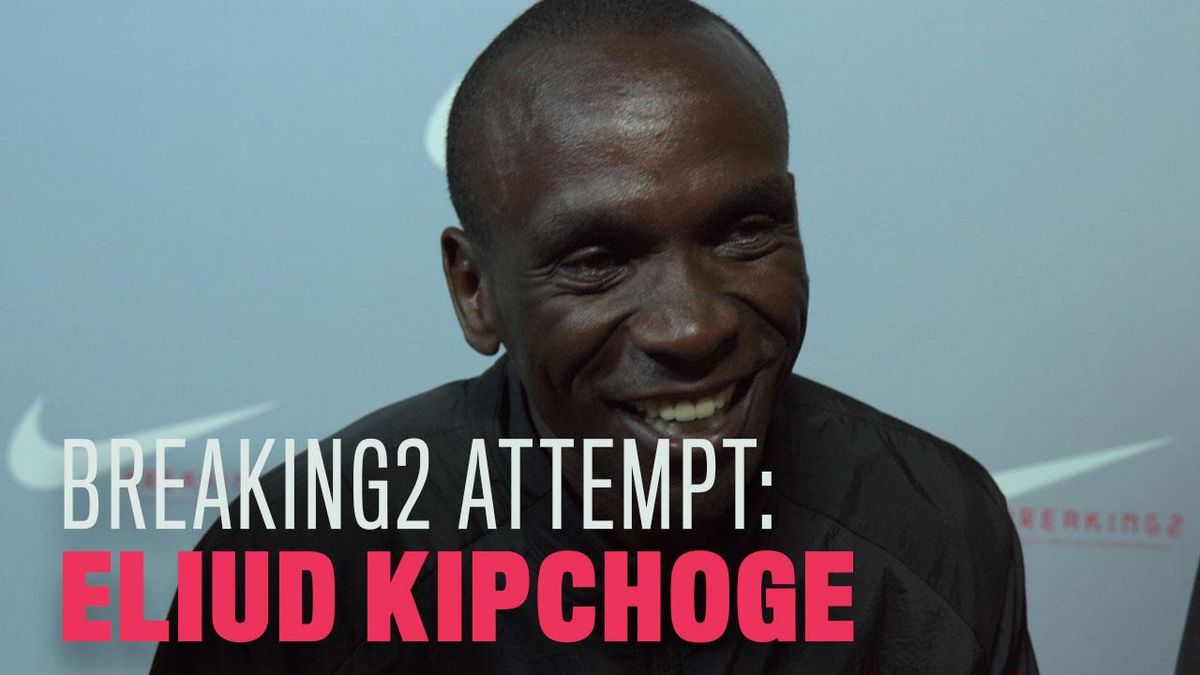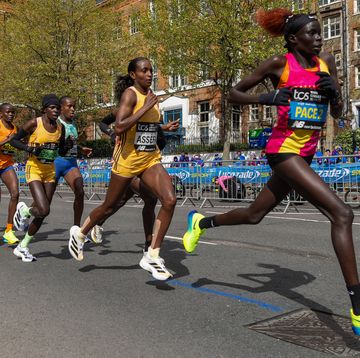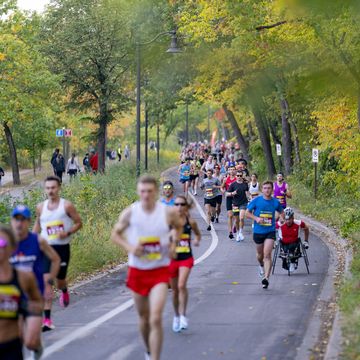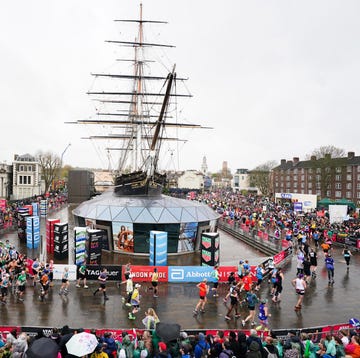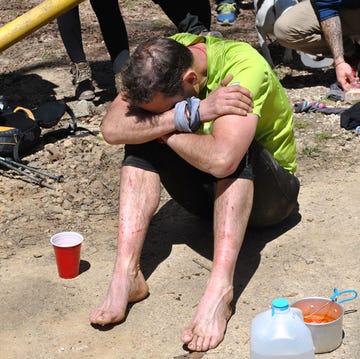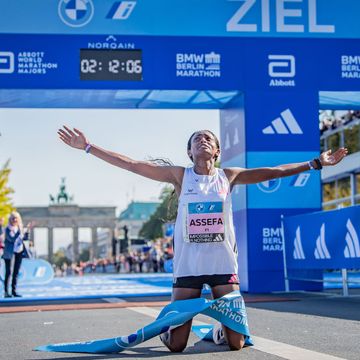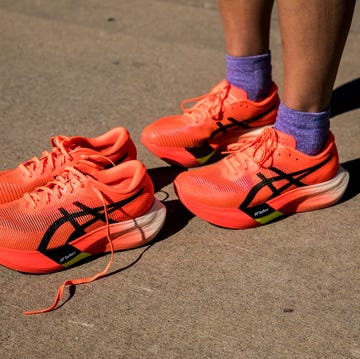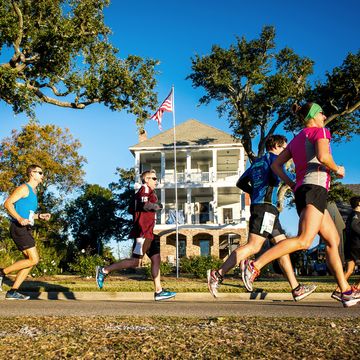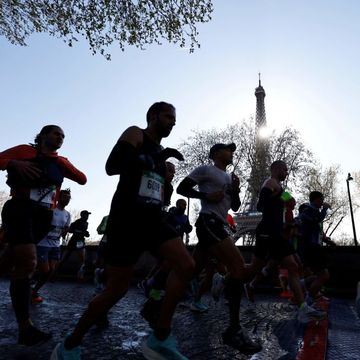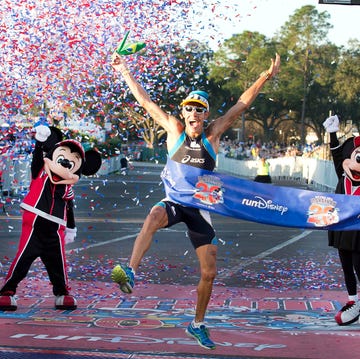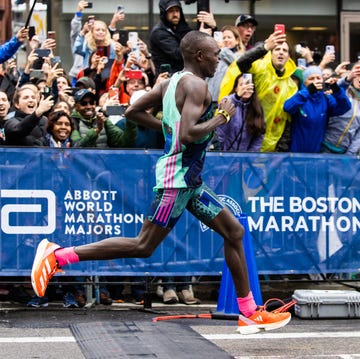One of the biggest topics in elite running in recent years has been the quest to break two hours in the marathon. Here’s what you need to know about the chase.
Why is the sub-two-hour marathon a big deal?
As was the case with the sub-four-minute mile, it’s a symbolic barrier that challenges current conceptions of what’s humanly possible. Also like the sub-four mile, it’s an easily understood quest that the general public, rather than just hardcore running fans, can take interest in.
What's the current world record in the marathon?
2:02:57, by Dennis Kimetto of Kenya at the Berlin Marathon in September 2014. Here is the progression of the world record and the 10 fastest marathoners and marathon courses in history.
How fast is a sub-two marathon?
Running 1:59:59 for the marathon entails averaging 4:35 per mile for 26.2 miles. Put another way, that’s almost eight and a half consecutive 5Ks in 14:13 each.
The current world record was run at an average pace of 4:41 per mile. While running six seconds per mile faster in a race is often achievable for regular runners, it’s a huge accomplishment for world-class runners.
Another way of considering a sub-two marathon is to compare it to equivalent times at other common distances. According to the Purdy tables, the most respected race-comparison tool, a 1:59:59 marathon is the equivalent of a 12:20 5K, 25:49 10K, and 57:12 half marathon. The current world records for those distances are 12:37, 26:17, and 58:23, respectively. Those latter marks are roughly in line with the current marathon record. Translation: A sub-two marathon would be a performance far superior to that ever produced in any other endurance event. It’s rare for a world record in one event to be much better qualitatively than other contemporary world records. (That said, one of the exceptions is the women’s marathon world record of 2:15:25, set by Paula Radcliffe in 2003, which remains qualitatively superior to other women’s distance records.)
What are the current organized efforts to break the two-hour barrier?
In late 2014, Yannis Pitsiladis, a professor of sports and exercise science at the University of Brighton in Britain, launched his Sub2Hr Project with an initial goal of breaking the barrier within five years. Pitsiladis has struggled to raise the $30 million he estimates he’ll need to lead a runner under two hours in his stipulated timeline.
On December 12, 2006, Nike announced its Breaking2 project. Its goal was to have at least one of three top distance runners break two hours in the spring of 2017. See below for more details about Nike’s project.
Adidas is also reported to be working on a sub-two project. The last four world record holders—Kimetto, Wilson Kipsang, Patrick Makau, and Haile Gebrselassie—have been sponsored by Adidas.
How will the various projects overcome the current barriers to breaking two hours?
Pitsiladis’s project is heavy on science. He has drawn particular attention for suggesting a race could be held below sea level, such as at the Dead Sea, where there’s more oxygen in the air. He has also questioned whether current world-class training methods are based more on tradition than principles of exercise physiology.
For its event, run on May 6, 2017, Nike looked at every possible element known to affect marathon performance, including weather, course, pacing, nutrition, and, of course, shoes and other gear. Nike created a shoe with a spring plate in the sole for its sub-2 attempt.
Details about the Adidas project are scant—no timeline has been announced—but the attempt, unlike Nike’s, will reportedly be made on a current marathon course. If that’s the case, the logical choice would be Berlin, where the last six men’s world records have been set. Like Nike, Adidas is counting on innovations in shoe technology to get to sub-2. In February, the company launched its sub-2 shoe at the Tokyo Marathon, where winner and former world record-holder Wilson Kipsang wore it. (Despite lowering the Tokyo event record, Kipsang was nearly 4 minutes off the sub-2 barrier.)
What has been the reaction to these projects?
Running fans have been simultaneously enthusiastic about the pursuit of a huge barrier and critical of some of the aspects of the planned attempts.
In the case of Pitsiladis’s project, runners and scientists alike have questioned the underlying premise that sub-two is mostly a matter of the correct application of exercise science. The Nike and Adidas projects have been criticized by some for being more corporate marketing campaigns than genuine athletic competitions.
RELATED: Read all of RW's coverage of the sub-two-hour quest
So Nike’s May 2017 event is the only attempt with a known date. Where was it held, and what happened?
The attempt was held on May 6, 2017 at the Formula One oval in Monza, Italy. The three runners making the attempt did about 17.5 laps of a roughly 1.5-mile circuit.
Eliud Kipchoge of Kenya, the 2016 Olympic marathon champion, came agonizingly close to breaking 2:00. He finished in 2:00:25, or roughly 1 second per mile too slow. Zersenay Tadese, the world record-holder in the half marathon, finished in 2:06:51. Lelisa Desisa, a two-time Boston Marathon winner, finished in 2:14:10.
Although Kipchoge ran more than two and a half minutes faster than anyone else ever has for the marathon, his time won’t count as a world record, because the race didn’t follow two standard rules of competition. First, pacers entered and exited the course throughout the race. Second, the runners received fluids from a moving person (in this case, on a moped) rather than from a stationary set-up.
An interview with Eliud Kipchoge after his attempt to run 26.2 miles in under two hours.
Were the Nike runners drug tested?
Nike said that an independent body conducted post-race drug testing. Nike did not reveal whether the three sub-2 aspirants were subject to out-of-competition testing in the months leading up to the event. None of the three runners are known to have missed or failed a drug test, and none have been closely associated with known dopers.
In a record-eligible setting, would a shoe with a spring in the sole count for record purposes?
The relevant International Association of Athletics Federations rule, #143.2, states:
Athletes may compete barefoot or with footwear on one or both feet. The purpose of shoes for competition is to give protection and stability to the feet and a firm grip on the ground. Such shoes, however, must not be constructed so as to give an athlete any unfair additional assistance, including by the incorporation of any technology which will give the wearer any unfair advantage. A shoe strap over the instep is permitted. All types of competition shoes must be approved by IAAF.
The key phrase pertaining to a shoe with a spring is “no unfair additional assistance.” Adidas’s Boost foam, which was in the shoes used to set the current world record, boasts “the highest energy return in the running industry” and has been shown in peer-reviewed studies to boost running economy. Whether Nike’s carbon plate would constitutes “unfair additional assistance” while Adidas’s Boost foam doesn’t could be a source of great debate. Nike has said that the IAAF has cleared its shoe for competition, but the IAAF hasn’t yet independently verified that statement.
Will Nike engineer a repeat of the May 2017 Breaking2 attempt?
At this point, Nike has not announced plans for a follow-up.
When is sub-two under record-eligible conditions going to occur?
Most likely not for a long time. Our data-driven report on the barrier, published in 2014, predicted running fans would first get to celebrate the accomplishment in 2075.
As with any record, the faster the marathon mark becomes, the harder it gets to break. Although it might seem that the marathon record has been in free fall in recent years, that’s not really the case. It took four years, from 1999 to 2003, for the record to go from the 2:05s to the 2:04s. Getting into the 2:03s took until 2008, a span of five years. And moving into the 2:02s, which has happened only once, and just barely, took until 2014, or six years.
Although a sub-two marathon is often likened to the quest for the first sub-four mile, the analogy is far from perfect. When Roger Bannister ran 3:59.4 for the mile in 1954, that performance wasn’t levels of magnitude better than other world records of the time. In contrast, and as noted above, a sub-two marathon would be vastly superior to the current world records for other standard distance races.
Bannister’s sub-four provides helpful context in another way. In his landmark record, Bannister passed halfway in 1:59. The half-mile world record at the time was 1:48. Bannister didn’t have to come anywhere near a world-class time just to reach the halfway mark on pace. That is not currently the case with a sub-two marathon. Running a half marathon in under an hour is still a world-class performance; Olympic marathon champ Kipchoge’s best at the distance is 59:30 on a record-eligible course. Going sub-two would require the current crop of elite marathoners to run close to an all-out performance for the first half of the race, and then do so again for another 13.1 miles.
All that said, Kipchoge’s 2:00:25 is likely to alter elites’ ideas about what is currently possible. Kipchoge appears capable of running in the low 2:02 range on a record-eligible course such as Berlin.

Scott is a veteran running, fitness, and health journalist who has held senior editorial positions at Runner’s World and Running Times. Much of his writing translates sport science research and elite best practices into practical guidance for everyday athletes. He is the author or coauthor of several running books, including Running Is My Therapy, Advanced Marathoning, and Meb for Mortals. Scott has also written about running for Slate, The Atlantic, the Washington Post, and other members of the sedentary media. His lifetime running odometer is past 110,000 miles, but he’s as much in love as ever.
